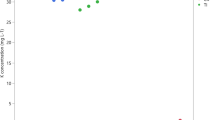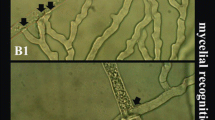Abstract
The efficacy of 20 organic and inorganic sodium salts, and two synthetic fungicides against eight bean root rot pathogens—Fusarium equiseti, F. proliferatum, F. semitectum, F. solani f. sp. phaseoli, F. verticillioides, Rhizoctonia solani AG4–HG I, Macrophomina phaseolina and Sclerotium rolfsii—were evaluated in this study. Accordingly to preliminary in vitro tests, only captan, benzoate and metabisulfite (2 %) were able to completely inhibit mycelial growth of all eight fungi. Moreover, no significant differences were observed among the inhibitory effect of these three compounds and EDTA (P ≤ 0.05). With few exceptions, the ED50 values indicated captan to have a greater effect against fungi than benzoate, EDTA and metabisulfite. However, captan, benzoate and EDTA all had MIC values that varied greatly from that of metabisulfite. Whereas captan, benzoate and EDTA showed fungitoxic activity against all fungi tested at concentrations greater than 0.1 %, metabisulfite showed fungitoxic activity against all fungi tested at concentrations of 0.025–0.25 %. Soil bioassays showed 0.25 % metabisulfite to completely inhibit mycelial growth of F. proliferatum, F. semitectum, R. solani AG–4 HG I, M. phaseolina and S. rolfsii, but not F. equiseti, F. solani f. sp. phaseoli and F. verticillioides. Higher concentrations of captan and benzoate were required to achieve total inhibition in soil bioassays when compared to metabisulfite, whereas EDTA was not able to completely inhibit growth of any of the fungi tested, even at the highest concentration. Moreover, the application of 1.0–2.0 % EDTA was found to be phytotoxic to bean seeds in terms of both seed germination and root elongation, whereas 0.1–0.75 % captan, 0.1–0.75 % benzoate and 0.1 % metabisulfite did not exhibit any phytotoxicity in terms of germination; 0.5 % captan, 0.1 % benzoate and 0.1 % metabisulfite did, however, have a negative effect on root elongation.
The results of pH studies also demonstrated all eight fungi tested to be capable of growth in both acidic and basic environments, although the growth of some species was inhibited at the lowest value tested (pH 2), and the growth of all species was totally inhibited at the highest value tested (pH 12).
Zusammenfassung
Die Wirksamkeit von 20 organischen und anorganischen Natriumsalzen und zwei synthetischen Fungiziden gegen acht Wurzelfäuleerreger bei Bohnen – Fusarium equiseti, F. proliferatum, F. semitectum, F. solani f. sp. phaseoli, F. verticillioides, Rhizoctonia solani AG4–HG I, Macrophomina phaseolina und Sclerotium rolfsii – wurde in dieser Studie beurteilt. Vorläufigen In-vitro-Tests zufolge konnten nur Captan, Benzoat und Metabisulfit (2 %) das Myzelwachstum aller acht Pilze vollständig hemmen. Außerdem wurden keine signifikanten Unterschiede zwischen der hemmenden Wirkung dieser drei Verbindungen und von EDTA festgestellt (P ≤ 0,05). Mit wenigen Ausnahmen deuteten die ED50-Werte darauf hin, dass Captan eine stärkere Wirkung gegen Pilze hat als Benzoat, EDTA und Metabisulfit. Captan, Benzoat und EDTA wichen aber stark in ihren MHK-Werten von Metabisulfit ab. Während Captan, Benzoat und EDTA bei Konzentrationen über 0,1 % eine fungitoxische Wirkung gegen alle getesteten Pilze zeigten, zeigte Metabisulfit bei Konzentrationen zwischen 0,025 und 0,25 % eine fungitoxische Wirkung gegen alle getesteten Pilze. Boden-Bioassays ergaben, dass 0,25 % Metabisulfit das Myzelwachstum von F. proliferatum, F. semitectum, R. solani AG–4 HG I, M. phaseolina und S. rolfsii vollständig hemmt, nicht aber das von F. equiseti, F. solani f. sp. phaseoli und F. verticillioides. Höhere Konzentrationen als bei Metabisulfit waren von Captan und Benzoat erforderlich, um in Boden-Bioassays eine vollständige Hemmung zu erreichen, wohingegen EDTA das Wachstum keines der getesteten Pilze vollständig hemmen konnte, auch nicht in der höchsten Konzentration. Außerdem wurde der Einsatz von 0,1–2,0 % EDTA als phytotoxische für Bohnensaat erkannt, was die Saatkeimung und das Längenwachstum der Wurzeln betrifft, wohingegen 0,1 − 0,75 % Captan, 0,1 − 0,75 % Benzoat und 0,1 % Metabisulfit keine phytotoxische Wirkung auf die Keimung aufwiesen. 0,5 % Captan, 0,1 % Benzoat und 0,1 % Metabisulfit hatten allerdings negative Auswirkungen auf das Längenwachstum der Wurzeln.
Die Ergebnisse von pH-Studien zeigten auch, dass alle acht getesteten Pilze sowohl in saurem als auch in basischem Milieu wachsen können, obwohl das Wachstum mancher Spezies beim geringsten getesteten pH-Wert (2) und das Wachstum aller Spezies beim höchsten getesteten pH-Wert (12) gehemmt wurde.

Similar content being viewed by others
References
Abawi GS, Pastor Corrales MA (1990) Root rots of beans in Latin America and Africa: diagnosis, research methodologies, and management strategies. Centro Internacional de Agricultura Tropical (CIAT), Cali, p 114
Abawi GS, Ludwig JW, Gugino BK (2006) Bean root rot evaluation protocols currently used in New York. Annu Rep Bean Improv Coop 49:83–84
Al-Askar AA, Ghoneem KM, Rashad YM (2013) Management of some seed-borne pathogens attacking alfalfa plants in Saudi Arabia. African J Microbiol Res 7(14):1197–1206
Andres Ares JL, Rivera Martinez A, Pomar Barbeito F (2006) Short communication. Telluric pathogens isolated from bean plants with collar and root rots in northwest Spain. Spanish J Agricult Res 4(1):80–85
Anonymous (2013) U.S. Food and Drug Administration (FDA). http://www.fda.gov/Food/IngredientsPackagingLabeling/GRAS/SCOGS/ucm084104.htm. Accessed 2 July 2014
Aoki T, Tanaka F, Suga H, Hyakumachi M, Scandiani MM, O’Donnell K (2012) Fusarium azukicola sp. nov., an exotic azuki bean root-rot pathogen in Hokkaido, Japan. Mycologia 104(5):1068–1084
Araùjo ASF, Monteiro RTR (2005) Plant bioassays to assess toxicity of textile sludge compost. Sci Agric Piracicaba Brazil 62:286–290
Arslan U, Ilhan K, Karabulut OA (2006) Evaluation of food additives and low-toxicity compounds for the control of bean rust and wheat leaf rust. J Phytopath 154:534–541
Arslan U, Kadir I, Vardar C, Karabulut OA (2009) Evaluation of antifungal activity of food additives against soilborne phytopathogenic fungi. World J Microbiol Biotech 25:537–543
Beldek Ö (2013) Determination of pathogenicities and Fusarium species agent of root rot and wilt in bean growing areas in Samsun province. Master Thesis. University of Ondokuz Mayıs, Samsun. 69 pp
Brul S, Coote P (1999) Preservative agents in foods—mode of action and microbial resistance mechanisms, a review. Int J Food Microbiol 50:1–17
Buruchara RA, Camacho L (2000) Common bean reaction to Fusarium oxysporum f. sp. phaseoli, the cause of severe vascular wilt in Central Africa. J Phytopath 148:39–45
Campanella V, Ippolito A, Nigro F (2002) Activity of calcium salts in controlling Phytophthora root rot of citrus. Crop Protect 21:751–756
Davidson PM, Sofos JN, Branen AL (2005) Antimicrobials in food, 3rd edn. CRC Press, USA, p 721
DePasquale DA, Montville TJ (1990) Mechanism by which ammonium bicarbonate and ammonium sulfate inhibit mycotoxigenic fungi. Appl Environment Microbiol 56:3711–3717
Di Salvatore M, Carafa AM, Carratù G (2008) Assessment of heavy metals phytotoxicity using seed germination and root elongation tests: a comparison of two growth substrates. Chemosph 73(9):1461–1464
Elad Y, Katan J, Chet I (1980) Physical, biological, and chemical control integrated for soilborne diseases in potatoes. J Phytopath 70:418–422
El-Sheikh-Aly MM, Felaifel MSA, Fouad NA, Badawy HMA (1998) Comparative effectiveness of some fungicides and salts applied preharvest or postharvest for controlling pear fruit rots. Annals Agricul Sci Cairo 1:135–149. (Special Issue)
El-Shenawy MA, Marth EH (1988) Sodium benzoate inhibits growth of or inactivates Listeria monocytogenes. J Food Prot 51:525–530
Fan CM, Xiong GR, Qi P, Ji GH, He YQ (2008) Potential biofumigation effects of Brassica oleracea var. caulorapa on growth of fungi. J Phytopath 156:321–325
Gould GW, Russell NJ (1991) Sulphite. In: Russell NJ, Gould GW (eds) Food preservatives. Blackie, Glasgow, p 72
Hagedorn DJ, Inglis DA (1986) Handbook of bean diseases. Cooperative Extension Publications, Wisconsin, p. 28
Hall R (1991) Compendium of bean diseases, APS Press, USA, p. 102
Hatat G, Özkoç İ (1997) Bean root rot disease incidence and severity in Samsun and fungi associated with bean roots and soils. Turk J Agricult Forest 21:593–597
Hervieux V, Yaganza ES, Arul J, Tweddell RJ (2002) Effect of organic and inorganic salts on the development of Helminthosporium solani, the causal agent of potato silver scurf. Plant Dis 86:1014–1018
Latifa A, Idriss T, Hassan B, Amine SM, El Hassane B, Abdellah ABA (2011) Effects of organic acids and salts on the development of Penicillium italicum: the causal agent of citrus blue mold. Plant Path J 10:99–107
Mecteau MR, Arul J, Tweddell RJ (2002) Effect of organic and inorganic salts on the growth and development of Fusarium sambucinum, a causal agent of potato dry rot. Mycol Res 106:688–696
Mecteau MR, Arul J, Tweddell RJ (2008) Effect of different salts on the development of Fusarium solani var. coeruleum, a causal agent of potato dry rot. Phytoprot 89:1–6
Mills AAS, Platt HW, Hurta RAR (2004) Effect of salt compounds on mycelial growth, sporulation and spore germination of various potato pathogens. Posthar Biol Technol 34:341–350
Montiel Gonzalez L, Gonzalez Flores F, Sanchez Garcia BM, Guzman Rivera S, Gamez Vazquez FP, Acosta Gallegos JA, Rodriquez Guerra R, Simpson Williamson J, Cabral Enciso M, Mendoza Elos M (2005) Fusarium species on bean (Phaseolus vulgaris L.) roots causing rots, in fives states of Central Mexico. Rev Mex Fitopatol 23(1):1–10
Mwang’ombe AW, Thiong’o G, Olubayo FM, Kiprop EK (2007) Occurrence of root rot disease of common bean (Phaseolus vulgaris L.) in association with bean stem maggot (Ophyiomia sp.) in Embu District, Kenya. Plant Path J 6(2):141–146
Nisa T, Wani AH, Bhat MY, Pala SA, Mir RA (2011) In vitro inhibitory effect of fungicides and botanicals on mycelial growth and spore germination of Fusarium oxysporum. J Biopest 4(1):53–56
Olivier C, Halseth DE, Mizubuti ESG, Loria R (1998) Postharvest application of organic and inorganic salts for suppression of silver scurf on potato tubers. Plant Dis 82:213–217
Olivier C, MacNeil CR, Loria R (1999) Application of organic and inorganic salts to field-grown potato tubers can suppress silver scurf during potato storage. Plant Dis 83:814–818
Palmer CL, Horst RK, Langhans RW (1997) Use of bicarbonates to inhibit in vitro colony growth of Botrytis cinerea. Plant Dis 81:1432–1438
Palou L, Smilanick JL, Usall J, Vinas I (2001) Control of postharvest blue and green molds of oranges by hot water, sodium carbonate and sodium bicarbonate. Plant Dis 85:371–376
Palou L, Usall J, Smilanick JL, Aguilar MJ, Vinas I (2002) Evaluation of food additives and low-toxicity compounds as alternative chemicals for the control of Penicillium digitatum and Penicillium italicum on citrus fruit. Pest Manag Sci 58:459–466
Punja ZK, Grogan RG (1982) Effects of inorganic salts, carbonate-bicarbonate anions, ammonia, and the modifying influence of pH on sclerotia germination of Sclerotium rolfsii. Phytopath 72:635–639
Punja ZK, Gaye MM (1993) Influence of postharvest handling practices and dip treatments on development of black root rot on fresh market carrots. Plant Dis 77:989–995
Punja ZK, Grogan RG, Unruh T (1982) Comparative control of Sclerotium rolfsii on golf greens in northern California with fungicides, inorganic salts, and Trichoderma spp. Plant Dis 66:1125–1128
Russell AD (2005) Mechanisms of action, resistance, and stress adaptation. In: Michael Davidson P, Sofos JN, Branen AL (eds). Antimicrobials in food, 3rd edn.Boca Raton, CRC Press, pp 633–657
Türkkan M, Erper I (2014) Evaluation of antifungal activity of sodium salts against onion basal rot caused by Fusarium oxysporum f. sp. cepae. Plant Prot Sci 50:19–25
Valencia-Chamorro SA, Palou L, del Rio MA, Perez-Gago MB (2008) Inhibition of Penicillium digitatum and Penicillium italicum by hydroxypropyl methylcellulose-lipid edible composite films containing food additives with antifungal properties. J Agricult Food Chem 56:11270–11278
Yuen GY, Schroth MN, Weinhold AR, Hancock JG (1991) Effects of soil fumigation with methyl bromide and chloropicrin on root health and yield of strawberry. Plant Dis 75:416–420
Ziv O, Zitter TA (1992) Effects of bicarbonate and film-forming polymers on cucurbit foliar diseases. Plant Dis 76:513–517
Acknowledgements
The authors thank Prof. Dr. Gürsel Karaca, Plant Protection Department, Agriculture Faculty, Süleyman Demirel University, for her careful proofreading, and Dr. Melike Çebi Kılıçoğlu for Rhizoctonia solani AG–4 HG I isolate.
Author information
Authors and Affiliations
Corresponding author
Rights and permissions
About this article
Cite this article
Türkkan, M., Erper, İ. Inhibitory Influence of Organic and Inorganic Sodium Salts and Synthetic Fungicides Against Bean Root Rot Pathogens. Gesunde Pflanzen 67, 83–94 (2015). https://doi.org/10.1007/s10343-015-0339-z
Received:
Accepted:
Published:
Issue Date:
DOI: https://doi.org/10.1007/s10343-015-0339-z




